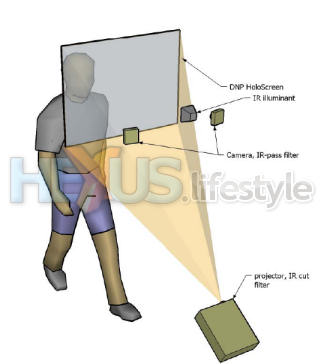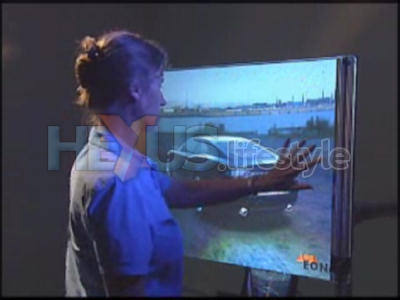Microsoft is promising to bring to market late this year a multi-point, 3D touch-screen technology - TouchLight - reminiscent of the video-communication screens seen in many sci-fi movies.
Unlike conventional touch-sensitive panels, Microsoft's impending product is intended to let you manipulate on-screen images with two hands - and the separate digits on each - and can also be set up for use by more than one pair of hands.
TouchLight's first major unveiling was at the 2004 International Conference on Multimodal Interfaces (ICMI 2004) where Microsoft developer Andy Wilson, whose baby it is, gave a talk (view the PDF; right-click to download) about the original two-camera-plus-back-projector system.
Andy followed up with a presentation at Siggraph 2005, with the same title, TouchLight: An Imaging Touch Screen and Display for Gesture-Based Interaction.
Think of the screens used in sci-fi movies such as Earth: Final Conflict, The Matrix Reloaded and Minority Report - and the UK's own Red Dwarf TV series - and you'll have a good idea of what Microsoft is planning to unleash. And, because the screen is transparent, video conferencing calls would mean that the users at each end would be able to look one another straight in the eye.
According to a video interview on CNET's News.com with David Harnett, Microsoft's senior director of IP Ventures (Microsoft's venture-capital arm), the current version of TouchLight - and presumably the launch version - will be using a three-camera system and running on Windows PCs using code developed in house.
One company, EON Reality, has stuck a deal with Microsoft to use TouchLight in its existing commercial, automotive, aerospace and defence-industry products - a deal that also involves inward investment by Microsoft's IP Ventures.
EON says that its customers will be able to use the technology for dynamic marketing displays, product demonstrations and "truly interactive" training experiences. Within the next two years, the company reckons, the technology will be used in stores for "advanced shopping experiences and interactive technical support". Products and assemblies, it says, will appear to float in the air during interaction. The company also says that technology could be affordable enough for desktops within the next two to three years.
To see more footage of TouchLight in action, check out EON Reality's demo video (WMV format - 5.49MB download) and the videos on Slashgear.
Will TouchLight go the way of so many of Microsoft's big hardware ideas or is it something that might actually catch on? We haven't a clue but would love to hear your thoughts and prejudices over in this thread in the HEXUS.community.
HEXUS.links
HEXUS.community :: discussion thread about this articleExternal.links
Microsoft - Andy Wilson's ICMI2004 TouchLight presentation (PDF - click to view; right-click to download)EON Reality press release - EON Reality Will Be First Company to Bring Next-Generation 3-D Technology to Market
EON Reality - demo video (WMV format - 5.49MB)
Siggraph 2005 - Overview of Andy Wilson's TouchLight presentation
CNET's News.com - video interview about TouchLight with Microsoft's David Harnett
Slashgear - more videos about LightTouch
Update - August 17, 2006, 18:00
This article has been updated to include information about the deal between Microsoft and EON Reality and to add one more image















